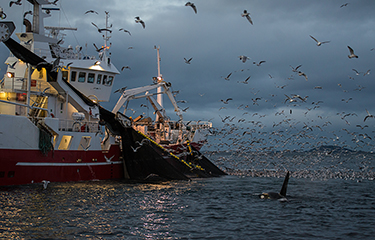Even amid global logistical challenges brought by the ongoing conflict in Ukraine and a new wave of COVID-19 shutdowns in China, Norway’s seafood industry managed to earn a record first-quarter value of NOK 34 billion (USD 3.9 billion, EUR 3.6 billion) from its fisheries and aquaculture product exports to overseas markets in the opening three months of 2022.
Compared with Q1 2021, the export value of Norway's seafood exports increased 22 percent, or NOK 6.2 billion (USD 713.4 million, EUR 652.2 million), with the United States providing the industry’s largest growth market in the quarter.
Exports to the U.S. increased by NOK 785 million (USD 90.3 million, EUR 82.6 million) to a total of NOK 2.6 billion (USD 299.1 million, EUR 273.5 million). France followed with growth of NOK 730 million (USD 84 million, EUR 76.8 million) to NOK 2.5 billion (USD 287.6 million, EUR 263 million), and then China with a rise of NOK 668 million (USD 76.9 million, EUR 70.3 million) to NOK 1.8 billion (USD 207.1 million, EUR 189.3 million).
Norwegian Seafood Council CEO Renate Larsen said that despite the new record value, it is a “demanding time” to be engaged in global trade.
“A month of war has resulted in complicated flows of goods and more expensive logistics,” Larsen said. “We have the lowest export volume of Norwegian seafood in a first quarter for six years. The record-setting export value is therefore driven by strong price growth for many species. The salmon price has remained at a high level, at the same time as we have a record value for cod and saithe so far this year.”
In the quarter, Norway exported 283,200 metric tons (MT) of farmed Atlantic salmon, worth a record NOK 23.2 billion (USD 2.7 billion, EUR 2.4 billion), with the export volume falling 5 percent and the value increasing 33 percent compared with the corresponding period of 2021, according to the NSC.
Poland, France, and the United States offered the largest markets for the species, with the average price for fresh whole salmon increasing from NOK 54.29 (USD 6.25, EUR 5.71) to NOK 78.37 (USD 9.02, EUR 8.24) per kilogram.
“The loss of exports to Belarus and Ukraine has had a relatively small impact on salmon exports. Last year, the share of these markets was about 2 percent of total salmon exports. However, high salmon prices and increased costs for shipping to Asia led to a shift in the flow of goods from Asia to the E.U. in March. This is the opposite of the trend from January and February,” NSC Seafood Analyst Paul Aandahl said.
Norway’s salmonid sector also exported 11,600 MT of trout worth NOK 945 million (USD 108.7 million, EUR 99.4 million), with the volume falling 4 percent and the value rising 28 percent compared with Q1 2021. The United States, Thailand, and Poland provided the largest trout markets.
Norway’s whitefish sector, meanwhile, shipped a total 26,100 MT of fresh cod in the first three months, earning a Q1 record NOK 1.3 billion (USD 149.6 million, EUR 136.7 million), with the volume falling 10 percent and the value climbing 19 percent year-on-year. Denmark, the Netherlands, and Portugal were the top three markets in the quarter.
The average export price of fresh whole cod in the quarter reached a record-high of NOK 46 (USD 5.29, EUR 4.84) per kilogram, which was 35 percent higher than in Q1 2021.
Norwegian frozen cod exports also broke records, with a volume of 29,600 MT that earned NOK 1.3 billion (USD 149.6 million, EUR 136.7 million). China, the United Kingdom, and the United States were the top markets.
From the pelagic sector, Norway exported 89,400 MT of herring, valued at NOK 1.1 billion (USD 126.6 million, EUR 115.7 million), with the volume and value down 25 percent and 14 percent respectively. It also sold 61,500 MT of mackerel worth NOK 1.2 billion (USD 138.1 million, EUR 126.2 million), representing a decrease in volume of 31 percent and a value drop of 15 percent.
Poland, Egypt, and Germany offered the largest markets for Norwegian herring in Q1, while South Korea, China, and Japan were the main markets for the country’s mackerel.
NSC said Q1 2022 herring exports were characterized by less Norwegian spring-spawning herring being landed compared with 2021. This, it said, was due to a combination of bad weather, occasional bad fishing, and an 8 percent reduction in quotas. In addition, a large part of the purse seine fleet was engaged in capelin fishing during parts of the period. In the first three months, 165,000 MT of herring were landed, compared with 198,000 MT in Q1 2021.
The reduced volume and good market demand has sent prices upwards. Frozen whole herring export prices averaged NOK 9.22 (USD 1.06, EUR 0.97) per kilogram, compared with NOK 7.50 (USD 0.86, EUR 0.79) in Q1 2021. Skinless fillets averaged NOK 15.77 (USD 1.81, EUR 1.66) per kilogram, against NOK 13.58 (USD 1.56, EUR 1.43) previously.
Norway’s shellfish sector exported 399 MT of king crab worth NOK 248 million (USD 28.5 million, EUR 26.1 million) in the period, representing a volume decrease of 43 percent and a similar value to a year previously. The United States, the Netherlands, and South Korea have been the product’s largest markets this year.
Norway also sold 1,300 MT of snow crab worth NOK 264 million (USD 30.4 million, EUR 27.8 million), up 22 percent and 54 percent, respectively. This was alongside 2,800 MT of shrimp with a value of NOK 207 million (USD 23.8 million, EUR 21.8 million), with the volume and value falling by 3 percent and 5 percent, respectively.
In 2021, Norway exported a record 3.1 million MT of seafood worth NOK 120.8 billion (USD 13.9 billion, EUR 12.7 billion).
Photo courtesy of wildestanimal/Shutterstock







